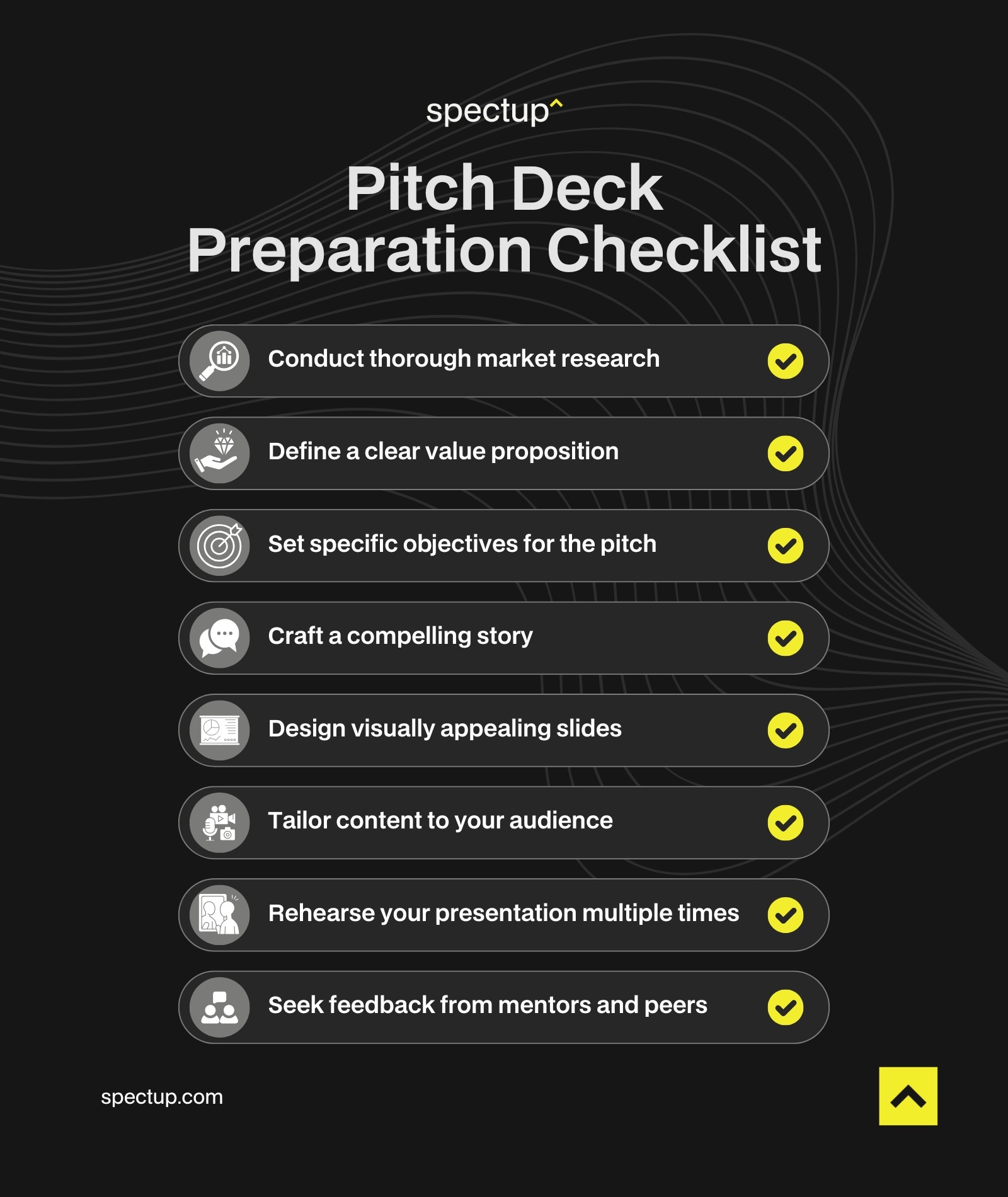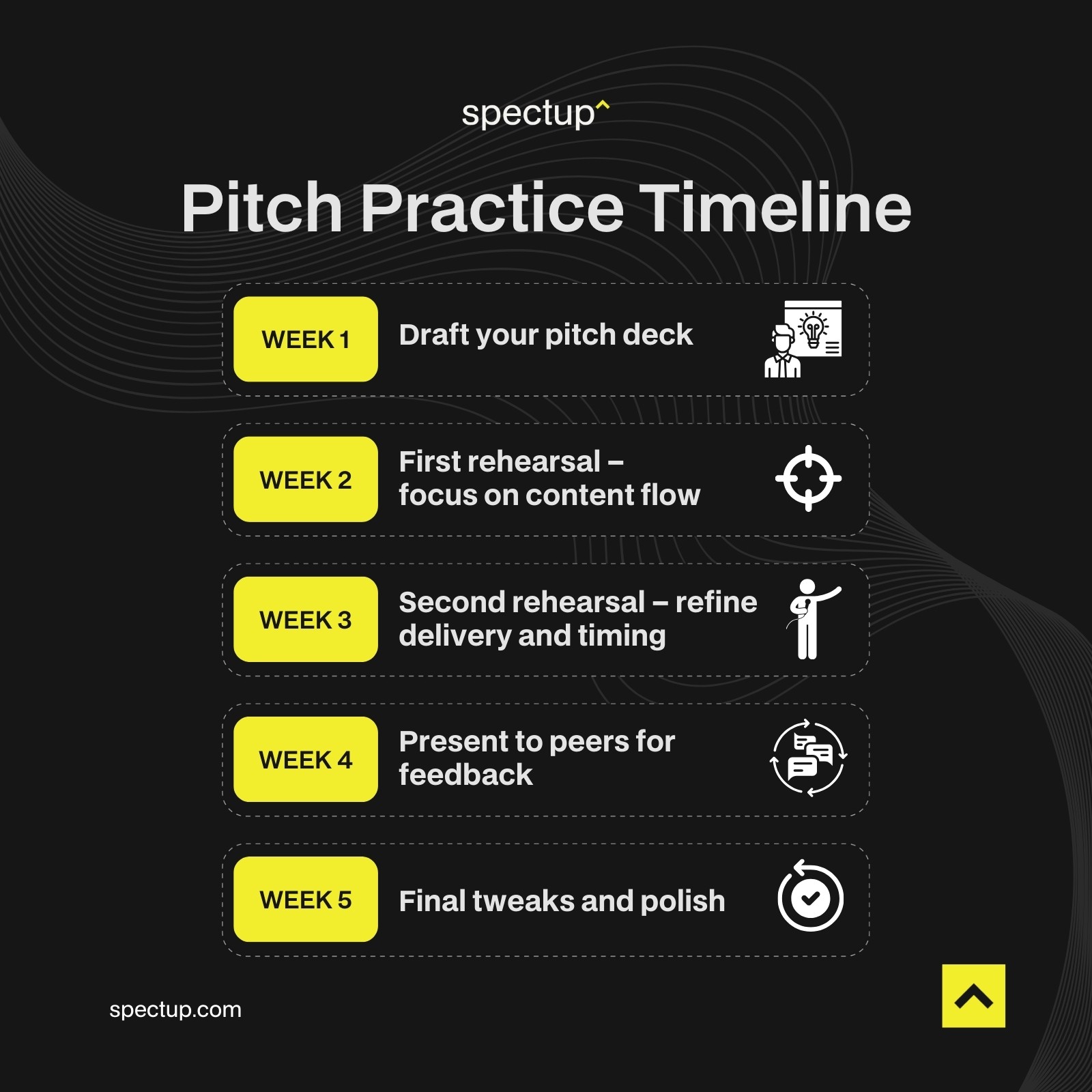Summary
Picture this: you’re standing there, ready to present your pitch deck. Heart’s racing a bit, and investors’ eyes are on you. This is the moment to make a lasting impact. But here’s a kicker—what matters isn’t only your deck or stats; it’s you.
Research shows that 55% of your impact is non-verbal—in how you stand, gesture, and even your expressions. Another 38% comes down to your voice—the tone, pace, and energy. Sure, that pitch deck’s the star, but you’re the one making it stick.
Today’s startups face a steep path to funding, and U.S. failure rates jumped by 60% recently due to cash shortages. Investors have become cautious, especially with so many “big ideas” and fewer solid plans. You’ve got to present your pitch deck with clarity, resilience, and a vision that stands out. Nail that, and your chances rise above the noise.
Here’s the scoop: this guide’s got you covered with sharp strategies to help you present your pitch deck with confidence and skill. No gimmicks—just solid tips to help you cut through the noise and secure the funding you need.
Key Takeaways:
Impact of Non-Verbal and Verbal Delivery: 55% of presentation impact is non-verbal, with 38% from voice—your delivery counts.
Challenges in Raising Funding: The 60% rise in U.S. startup failures highlights how essential a strong pitch is.
Purpose of the Guide: This resource offers strategies to help you present your pitch deck confidently and convincingly.

Understanding the Purpose of a Pitch Deck Presentation
What is a Pitch Deck?
So, here’s the gist: a pitch deck is that quick, visual summary of your business idea designed to catch the eye of prospective investors. Think of it as a compact version of your story, one that can fit into a few well-crafted slides.
Now, don’t confuse it with a business plan. While the plan is your all-in, nitty-gritty manual with every detail and number, a pitch deck is more like a sneak peek—something to spark interest and kickstart conversations. It’s got the highlights: the problem you’re solving, your unique solution, market potential, and, of course, why you’re the team to bring it to life.

The Goal of Your Pitch Presentation
Let’s be real: the goal here isn’t to land an immediate “yes.” It’s about capturing attention and sparking enough curiosity that investors want to hear more. You’re planting the seed, showing them why your idea has real potential and why it’s worth their time—and hopefully, their cash. Think of it like a movie trailer; it’s all about getting them intrigued enough to stay for the show.
Tailoring to Your Intended Audience
Now, here’s where it gets personal. Different investors care about different things, so don’t go in with a one-size-fits-all pitch. Some potential investors want to hear about your market’s size, while others are all about your team or the uniqueness of your idea. A little homework goes a long way. When you know what your intended audience values, you can hit those points in your pitch and up your chances of getting a thumbs-up.
In short, a great pitch deck doesn’t just present—it sparks interest and sets the stage for what could be the beginning of something big.
Preparing Your Pitch Decks

Research and Planning
Let’s be real—before you even think about pulling up those slides, you need to know who you’re pitching to. That means good ol’ market research. A pitch deck that shines doesn’t just happen; it’s built on a deep understanding of your target market and potential customers.
According to SlideGenius, a well-researched pitch stands out. Get into the details: Who are your customers? What makes them tick? What’s missing in their lives that you can offer? When you know these answers, your pitch moves from “Hey, look at this!” to “Here’s exactly what you need.”
Defining Your Value Proposition
Now comes the heart of it—your value proposition. It’s not enough to say, “We’re different.” No, you need to show why your idea is the one prospective investors should pay attention to. What sets you apart from the dozen other pitches they’ll hear that week? FinModelsLab emphasizes that a strong value proposition makes all the difference. Spell out exactly how you solve a problem, ease a hassle, or fill a gap in the market. Just keep it clear—ditch the jargon and keep it simple. People like simple.
Setting Clear Objectives
Finally, know what you’re after. Want a meeting? Need funding? Think about what’s on your agenda because that’ll steer your approach. Going into a pitch without clear objectives is like heading to a destination without a map—you’ll likely end up somewhere you didn’t want to be. Your pitch deck isn’t just a show; it’s a way to guide potential investors toward action, whatever that might be.
Crafting a Compelling Story

The Power of Storytelling in Pitch Decks
Picture this: you’re about to present your pitch deck to investors, and instead of diving into cold data, you open with a story. A relatable story can grab attention like nothing else, instantly connecting you with your audience. Research from WhitePage Studio shows that weaving storytelling into your pitch boosts your message’s stickiness, making it memorable long after the meeting ends. Investors don’t just want to see slides—they want to feel something. So, give them something to remember.
Structuring Your Narrative
The best stories don’t start with the hero winning; they start with a problem. In your pitch, kick off by setting up the problem slide—describe the issue your product or service addresses in a way that hits home. Investors need to see that you’re tackling something real. Startups calls the Problem Slide the "single most important slide" in any winning pitch deck. Then, bring in the hero: your solution. Show how your product or service can solve this issue, adding clarity and purpose to your pitch.
Making It Memorable
To make sure your pitch doesn’t fade into the background, add a few memorable moments. Use specific anecdotes or examples that bring your key points to life. A familiar example? Airbnb’s original pitch deck was built around stories and examples, showing real-world scenarios that investors could relate to. That approach didn’t just explain the concept; it brought it to life in a way that was hard to forget.
Incorporating storytelling into your pitch isn’t just a flashy add-on—it’s what makes your business feel real. By sharing a relatable story, mapping out the problem and solution, and bringing in anecdotes that illustrate your key points, you create a pitch that resonates and sticks with your target audience.

Key Components of an Effective Pitch Deck
Creating a pitch deck that truly stands out is key to grabbing the attention of investors and partners. Whether you’re a seasoned entrepreneur or just launching your first startup, knowing the key slides to include can make all the difference. Let’s walk through each essential part of a winning pitch deck.
Essential Slides to Include
Every effective pitch deck should have these key slides to tell your story clearly and convincingly.
Title Slide
Start strong with your company name, logo, and a catchy tagline that sums up your mission. Think of it as your first handshake—make it memorable. DocSend found that startups with a clear and engaging title slide are 2.5 times more likely to secure funding. So, don’t skip this!
Problem Slide
Here’s where you get real. Define the problem your target customer is struggling with. Be specific. If you’re tackling messy supply chains, explain the headaches businesses face daily. Showing you understand the issue makes your solution all the more necessary.
Solution Slide
Now, shine the spotlight on your product or service. Explain how it solves the problem you just outlined. Highlight what makes you different. For example, if your app uses AI to streamline logistics, detail how it makes things smoother. Remember Elon Musk’s words: “Great companies are built on great products.”
Market Opportunity
Let’s talk numbers. Show the size and growth potential of your potential market. Use stats to back it up—Statista says the global market for logistics technology is set to hit $175 billion by 2024. A big market means big opportunities for your business.
Business Model Slide
Investors want to know how you’ll make money. Outline your revenue streams, whether it’s subscriptions, sales, or licensing. If you’re offering a SaaS product, explain your pricing tiers and how you plan to attract customers. Clear business model clarity builds trust.
Marketing and Sales Strategy
How will you reach your audience? Describe your go-to-market plan and the sales channels you’ll use. Whether it’s digital ads, partnerships, or direct sales, show that you’ve got a solid plan. HubSpot notes that companies with a strong marketing strategy grow 3.5 times faster.
Competition Slide
Know your rivals. Analyze the competitive landscape by identifying your competitors and their solutions. Then, highlight your unique selling proposition (USP). Showing you know the competition and how you stand out is key.
Team Slide
People matter. Introduce your key team members and their expertise. Investors invest in people as much as ideas. Highlight experiences that show your team can execute the plan—like a member who’s successfully exited a startup before.
Financial Projections
Be realistic with your financial projections. Outline expected revenue, expenses, and profitability for the next 3-5 years. Include important metrics like customer acquisition cost (CAC) and lifetime value (LTV). Clear numbers show you understand your business’s financial side.
Traction Slide
Show what you’ve achieved so far. This could be user growth, revenue milestones, or partnerships. Add social proof like testimonials or press mentions. First Round Capital found that 42% of investors say traction is the most important factor in their decision to invest.
Funding Requirements and Use of Funds
Be upfront about how much you need to raise money and how you’ll use it. Break it down into categories like product development, marketing, and hiring. Transparency here builds investor trust.
Exit Strategy
Investors want to know how they’ll get their returns. Discuss potential exit strategies like acquisition or IPO. It shows you’re thinking long-term about the company’s future and their investment.
Engaging Structure
Keep your deck lively with bullet points and visuals. Don’t overload slides with text—stick to the essentials. A visually appealing deck keeps your audience hooked and makes your message stick.

Designing an Engaging Pitch Deck
Visual Appeal and Professionalism
Imagine kicking off your pitch with a stunning slide deck—one that’s sharp, clear, and professional. It’s the first thing investors see, so making it look polished shows them you’re serious. According to Venngage, 84% of presentations work better when visuals are consistent. You want them to listen to your pitch, not get distracted by mismatched fonts and random colors.
Tips for Effective Design
Consistency Across Slides: Here’s the trick: pick one font, one color scheme, and one style—and stick to it. Consistency doesn’t just look good; it helps keep attention on what matters—your message. A coherent design means they’re focused on your pitch, not on trying to figure out why every slide looks different.
Balancing Text and Visuals: Too much text? Boring. Too many visuals? Overwhelming. The key is balance. Mixing in charts, graphs, and images brings life to your slides without drowning out your words. Forbes found that using visuals increases audience engagement by 40%. You want them leaning in, not zoning out.
Using Pitch Deck Templates: Not everyone’s a designer, and that’s okay. Professional pitch deck templates can save the day. Templates make it easy to get that clean, professional look, even if design isn’t your strong point.
Need a little extra shine? Professional support can make a real difference. Consultancies like spectup are pros at pitch deck design services. They know how to create visually compelling decks that grab investors’ attention and keep it.
Tailoring Your Pitch to Your Audience
Understanding Your Potential Investors
Picture this: you’re standing in front of a room full of potential investors, each with their own agenda. If you know who’s across the table, you’ll know exactly what to emphasize. Venture capital firms often have a laser focus on high-growth potential, expecting numbers that show your business can scale fast.
On the other hand, angel investors tend to look more at the big picture—your vision, your team’s passion, maybe even a little about who you are as a founder. As Pitchfast points out, each investor type has its own “sweet spot”.
Customizing Content
Now that you’ve done your homework, tweak your pitch. If your audience is a venture capital firm, go deep on market size, potential growth, and scalability. They want to know how big you can go.
With angel investors, share a personal story or two—let them feel the real-world problem you’re solving. Show them you’re in this for the long haul and not just chasing the next big thing. FasterCapital notes that tailoring your pitch deck to match the investor’s priorities is key.
Adjusting Presentation Styles
Don’t forget, the delivery matters as much as the content. Some investors like a more formal, number-crunching approach—they want data, clear projections, and a straight-to-the-point delivery. Others? They prefer something a bit more relaxed and conversational.
Matching the presentation style to your audience isn’t just polite; it shows you’re attentive to their preferences, which, in turn, makes them feel like you’re the kind of founder who listens and adapts. Pitchfast even recommends switching up your style to keep each audience engaged.
Practicing Your Pitch Presentation

Importance of Rehearsal
Ever heard the old saying, "Practice makes perfect"? Well, it couldn’t be truer for delivering a confident pitch presentation. Rehearsal isn’t just about memorizing lines; it’s your chance to really dig into your material, smooth out the rough edges, and make sure you’re prepared for those tricky questions that always pop up. Time to Market says rehearsing lets you polish and refine until you're standing there with the kind of confidence that can win over any room.
Timing Your Presentation
Then there’s timing. Overrun your slot, and you risk losing your audience’s attention or, worse, cutting into valuable Q&A time. So, keep a timer handy during practice sessions. Break down your presentation into sections to stay within the time limit while pacing yourself naturally. Ink Narrates recommends timing each part to help you keep things balanced and well-paced, so you’re not rushing the good stuff.
Seeking Feedback
Finally, don’t just practice alone—get some real feedback! Running through your pitch in front of friends, peers, or mentors can be eye-opening. They’ll spot things you missed and give you a feel for what’s working and what’s not. As Collidu points out, rehearsing in front of others not only helps refine your delivery but also boosts your confidence on the big day.
And if you want that extra edge, consider reaching out to a consultancy like spectup. They specialize in fundraising consulting and growth strategy, helping startups fine-tune their pitch presentations to make a powerful impact.
Effective Presentation Techniques
Delivering your startup pitch deck effectively can make all the difference in winning over investors. Here are some proven techniques to ensure your presentation leaves a lasting impression.
Engage Your Audience
Confident Body Language: Stand tall, use open gestures, and maintain eye contact. This shows you believe in your business concept.
Connect Personally: Treat your pitch like a conversation with a friend. This natural approach keeps your audience interested.
Interactive Elements: Ask rhetorical questions or share brief anecdotes to make your presentation more relatable.
Clarity and Pacing
Speak Clearly: Ensure your voice is steady and articulate. Avoid mumbling or speaking too fast.
Steady Pace: Maintain a consistent speed to help your audience follow along without feeling rushed.
Simple Language: Break down complex ideas into easy-to-understand terms. As Carmine Gallo suggests, simplicity enhances comprehension.
Handle Nerves
Preparation: Practice your pitch multiple times to build confidence. Familiarity with your material reduces anxiety.
Deep Breathing: Use deep breathing techniques before and during your presentation to stay calm.
Positive Visualization: Imagine a successful pitch. This mental rehearsal can boost your confidence and performance.
Embrace Nervous Energy: Channel your anxiety into enthusiasm for your project.
Use Visual Aids Effectively
High-Quality Images: Use clear, relevant images that support your message without overwhelming the slide.
Minimal Text: Keep text concise. Use bullet points to highlight key information and avoid clutter.
Clear Graphs and Charts: Present data visually to make it easier to understand. According to the University of Minnesota, visuals can improve learning by up to 400%.
Consistent Design: Maintain a uniform style across all slides to keep the focus on your content.
Emphasize Key Points
Highlight Critical Information: Use bold text, color changes, or strategic placement to make important points stand out.
Repetition: Reinforce key messages by repeating them at different points in your presentation.
Vary Your Tone: Change your speaking tone to emphasize significant aspects of your pitch.
Pause for Effect: Allow moments of silence after important statements to let them sink in. Forbes notes that effective emphasis can increase retention rates by 25%.
Common Mistakes to Avoid
Crafting a startup pitch deck is no walk in the park. Even the best intentions can lead to slip-ups that might cost you valuable investment. Let’s spotlight some common mistakes so your pitch shines bright.
Overloading Slides with Information
Keep It Clean: Cramming too much info on one slide can overwhelm your audience. Stick to minimal text and highlight the essentials.
Visual Clarity: Swap lengthy paragraphs for charts and images. This keeps your presentation deck sharp and impactful.
Example: Instead of detailing every part of your marketing and sales plan on one slide, use bullet points to showcase key tactics.
Ignoring the Competition
Always Include a Competition Slide: Skipping this can make investors doubt your market knowledge. A competition slide shows you’ve done your homework.
Analyze Rivals: Clearly identify your competitors and explain how your business idea stands out from existing solutions.
Source Insight: Crunchbase reports that successful startups often dedicate a good chunk of their pitch to competitive analysis, highlighting their strategic edge.
Lack of Passion
Show Enthusiasm: Investors back people as much as ideas. If you’re not passionate about your business concept, why should they be?
Personal Stories: Share what drives you. Whether it’s overcoming a challenge or a spark of inspiration, let your passion shine.
Impact: Harvard Business Review found that passionate founders are 30% more likely to secure funding.
Not Knowing Your Numbers
Be Prepared: Investors will dive into your financial projections and key metrics. Know your profit and loss statement, customer acquisition cost (CAC), and lifetime value (LTV) inside out.
Accuracy Matters: Present realistic and well-researched numbers. Overly optimistic projections can hurt your credibility.
Expert Tip: Forbes states that 82% of investors find accurate financials crucial when evaluating a startup pitch deck.
Neglecting to Follow Up
Timely Communication: After your pitch, send a thank-you email and any requested info. It shows professionalism and keeps the conversation going.
Build Relationships: Even if investors aren’t ready to commit right away, staying in touch can open doors down the line.
Statistic: HubSpot revealed that 80% of investors appreciate prompt and thoughtful follow-ups, boosting future investment chances.
Avoiding these pitfalls can refine your startup pitch decks, helping you communicate your vision clearly, demonstrate your readiness, and showcase your passion.
Showcasing Your Team
Importance of the Team Slide
Let’s be real—investors aren’t just putting money into an idea; they’re putting it into people. The team slide is where you show them exactly who’s on your side and why it matters. It’s like introducing the cast of a movie, and you’re saying, “Look, these folks aren’t just here to fill seats—they’re here to make things happen.” In fact, 44% of investors prioritize the team as the main factor in an investor pitch.
Highlighting Expertise and Experience
When you introduce key team members, don’t just rattle off job titles. Share a bit about what each person brings to the table. Maybe your CTO’s a whiz at scaling tech solutions, or your Head of Sales has hit those tough sales goals at every company they’ve touched. Give them a snapshot of each person’s unique strengths, not just a title next to a name. Show how this lineup is poised to turn the dream into reality.
Demonstrating Capability
Here’s where you make it clear: this team isn’t just skilled; they’re equipped to tackle what lies ahead. Investors want to see how your team fits the early stage goals and long-term vision of the company. If you’ve got someone with a knack for crafting a solid financial model, say it loud. Show them how each person’s skills plug right into the business plan, turning potential into progress.
Using Data to Support Your Pitch
Importance of Data in Pitch Decks: Data supports claims and demonstrates business seriousness to investors.
Key Metrics: Highlight crucial metrics like customer acquisition cost (CAC), lifetime value (LTV), and monthly recurring revenue (MRR) to indicate growth and scalability.
Financial Projections: Present realistic and achievable financial forecasts for revenue, expenses, and profits over the next 3-5 years to showcase a clear path to profitability.
Use of Visuals: Incorporate charts and graphs to make data easily understandable and enhance retention, making complex information accessible at a glance.
Following Up After Your Presentation
Following up after a presentation is essential for securing investment and keeping your pitch top of mind for investors.
Timely and thoughtful follow-ups can increase the likelihood of future investment, as 80% of investors value them.
Be prepared to provide additional information requested by investors to demonstrate commitment and build trust.
Maintaining ongoing communication with investors helps develop relationships and keeps them engaged with your progress.
Consider seeking support from firms like spectup for managing investor relations and deal flow during the fundraising process.
Learning from Successful Pitch Decks
Ever wondered what makes a successful pitch deck stand out? Studying pitch deck examples from well-known startups can offer invaluable insights. Take Airbnb’s early pitch deck, for instance. It was simple yet powerful, clearly outlining their business idea and market potential without overwhelming investors with jargon.
Clarity and conciseness are key. Successful pitch decks often start with a compelling cover slide that grabs attention. They follow with a clear problem and a robust solution, backed by solid financial projections and impressive key metrics. Visuals play a crucial role too—Airbnb effectively used images and charts to illustrate their points, making the information easy to digest.
Applying these lessons to your own pitch deck means focusing on what truly matters. Keep your slides clean and straightforward, tell a story that resonates, and back up your claims with data. Investors appreciate when you can present your vision clearly and confidently. As you refine your pitch, think about how these successful pitch decks communicated their value and how you can do the same.

Conclusion
Wrapping it all up, and presenting your pitch deck effectively is a blend of strategy, clarity, and passion. From crafting a compelling story and using data to avoiding common mistakes, every step you take brings you closer to securing that crucial investment.
Don’t shy away from putting in the effort. Practice your delivery, seek feedback, and continuously refine your presentation. Remember, a great pitch deck isn’t just about showcasing your business idea; it’s about connecting with your audience and convincing them of your vision.
So, go ahead and apply these strategies to your pitch deck. With the right approach, you’ll be well on your way to making an effective presentation that captures the attention of potential investors and propels your startup toward success.
Niclas Schlopsna
Partner
Ex-banker, drove scale at N26, launched new ventures at Deloitte, and built from scratch across three startup ecosystems.







